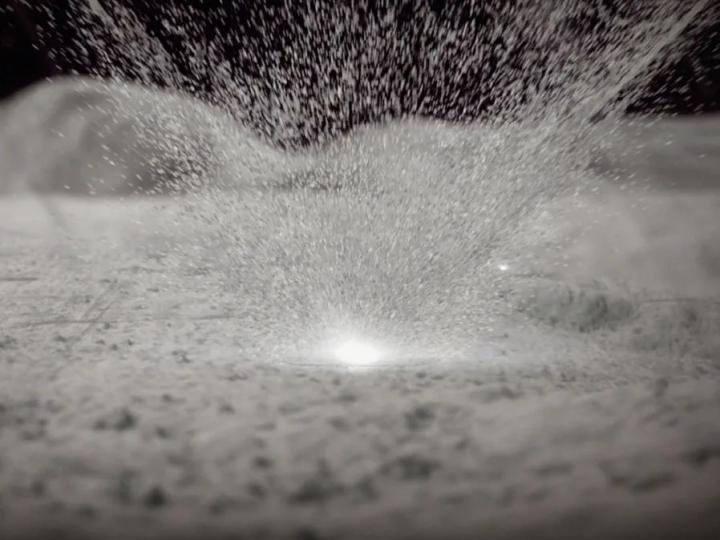1.11.2023
Astronomers show how a 50-meter space rock orbiting near Earth isn’t a typical asteroid: It probably blasted off the moon millions of years ago.

One might expect astronomers to have found all the near-Earth asteroids and comets already. But that’s not the case. Some lurk in orbital spots that are hard to see, because discovering them requires looking straight into the sun. One such object, dubbed Kamo’oalewa, evaded detection until seven years ago—and its origin has always been mysterious. Until now.
Astronomers first spotted Kamo’oalewa with a telescope atop the Haleakala volcano on Maui, in the Hawaiian Islands, and they gave it a Hawaiian moniker that means “oscillating celestial object.” It’s considered a “quasi-satellite” of the Earth, since from here it looks like a constant, if faint, companion, like a distant moon. But it’s actually soaring beyond our planet’s gravitational sphere of influence, and it orbits the sun, not the Earth.
Early on, University of Arizona astronomer Renu Malhotra suspected it didn’t come from the asteroid belt, the origin of most near-Earth objects. “From the properties of the orbit, we realized that it was different from other near-Earth asteroids, and it might potentially have a different source,” Malhotra says. Her team measured its light spectrum, which looked suspiciously similar to that of silicates found on the moon, and not on asteroids. They published those results in 2021.
They came up with a dramatic theory: that the tumbling 50-meter space rock was blasted off the moon thanks to an asteroid impact millions of years ago. Now, the team has figured out that Kamo’oalewa’s wobbling orbit is indeed consistent with that theory. They published their findings last week.
Malhotra and PhD student Jose Daniel Castro-Cisneros used numerical models to simulate the ways a hunk of moon rock could have been slammed into a space-bound trajectory. They modeled possible asteroid collisions with the moon’s surface that could have launched bits of regolith fast enough to reach escape velocity—meaning they wouldn’t fall back to the surface. Then they modeled those rocks’ subsequent orbits and assessed whether any ended up in a Kamo’oalewa-like path. Some do.
Such an investigation involves modeling a wide range of possible trajectories lunar fragments could take after being ejected by an impact. Malhotra and Castro-Cisneros find that an orbit like Kamo’oalewa’s is rare, but not impossible, arising in 0.8 percent of the scenarios they explored. That might seem unlikely, but those are better chances than those of the competing theory, which is that an asteroid hailing from the asteroid belt was gravitationally captured into this unstable orbit. Those odds, Castro-Cisneros says, are essentially nil.
Their analysis looks convincing, says Andrew Rivkin, a planetary scientist at Johns Hopkins University’s Applied Physics Laboratory who studies the composition of asteroids and who was not involved in the paper. “Short of going and grabbing a piece, like NASA just did with Bennu, this is probably as close to conclusive as we get,” he says. Rivkin emphasizes that Kamo’oalewa is an unusual object: Out of some 80,000 meteorites collected on Earth, only a few percent have come from the moon, and of the 1,382 meteorite falls observed and documented by people, none were lunar.
The researchers find that Kamo’oalewa has probably been hanging around for millions of years, not decades, like other objects in such orbits. But its orbit isn’t stable, thanks to the classic three-body problem, in which the chaotic gravitational influence of three bodies—the Earth, the sun, and Kamo’oalewa—will eventually nudge it so that it gets kicked out and flies away.
Their astronomical sleuthing continues, including examining lunar craters that have remained essentially undisturbed for eons. Small changes in the initial conditions of the models, such as the size of the asteroid that made the impact, where it hit the moon, and at what angle, have dramatic effects on an ejected lunar boulder’s trajectory. They infer a kilometer-sized asteroid made that critical crash, and they can make inferences about the impact too. “Based on the likely conditions to produce this kind of orbit, coming from the moon, that would require a crater millions of years old and tens of kilometers in size,” Castro-Cisneros says. It likely smashed into the trailing side of the moon, he says, and they’re now trying to pinpoint the precise crater that Kamo’oalewa launched from.
Kamo’oalewa’s lunar provenance also has implications for potentially hazardous Earth-bound asteroids that NASA and other organizations search the heavens for. It means people should also consider orbits originating from the moon, not just rocks flung out of the asteroid belt. NASA is scoping for asteroids 140 meters in diameter and larger, similar in size to the one the DART spacecraft smacked into to test deflection techniques. Near-Earth objects from ancient moon impacts would probably be 100 meters or smaller, Malhotra says, but those are nonetheless known as “city killers,” dangerous enough to cause widespread destruction if they were to strike the Earth.
That probably won’t be Kamo’oalewa’s fate, but Malhotra and Castro-Cisneros’ research shows that there are likely others out there like it somewhere.
Quelle: WIRED

